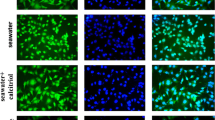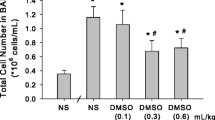ABSTRACT
Seawater instillation-induced acute lung injury involves oxidative stress and apoptosis. Although hydrogen gas inhalation is reportedly protective in multiple types of lung injury, the effect of hydrogen gas inhalation on seawater instillation-induced acute lung injury remains unknown. This study investigated the effect of hydrogen gas on seawater instillation-induced acute lung injury and explored the mechanisms involved. Rabbits were randomly assigned to control, hydrogen (2 % hydrogen gas inhalation), seawater (3 mL/kg seawater instillation), and seawater + hydrogen (3 mL/kg seawater instillation + 2 % hydrogen gas inhalation) groups. Arterial partial oxygen pressure and lung wet/dry weight ratio were detected. Protein content in bronchoalveolar lavage fluid (BALF) and serum as well as tumor necrosis factor (TNF)-α, interleukin (IL)-1β, and IL-6 levels were determined. Hematoxylin-eosin staining was used to monitor changes in lung specimens, and malondialdehyde (MDA) content and myeloperoxidase (MPO) activity were assayed. In addition, NF-E2-related factor (Nrf) 2 and heme oxygenase (HO)-1 mRNA and protein expression were measured, and apoptosis was assessed by measuring caspase-3 expression and using terminal deoxy-nucleotidyl transferase dUTP nick end-labeling (TUNEL) staining. Hydrogen gas inhalation markedly improved lung endothelial permeability and decreased both MDA content and MPO activity in lung tissue; these changes were associated with decreases in TNF-α, IL-1β, and IL-6 in BALF. Hydrogen gas also alleviated histopathological changes and cell apoptosis. Moreover, Nrf2 and HO-1 expressions were significantly activated and caspase-3 expression was inhibited. These results demonstrate that hydrogen gas inhalation attenuates seawater instillation-induced acute lung injury in rabbits and that the protective effects observed may be related to the activation of the Nrf2 pathway.











Similar content being viewed by others
REFERENCES
Idris, A.H., R.A. Berg, J. Bierens, L. Bossaert, C.M. Branche, A. Gabrielli, S.A. Graves, A.J. Handley, R. Hoelle, P.T. Morley, L. Papa, P.E. Pepe, L. Quan, D. Szpilman, J.G. Wigginton, and J.H. Modell. 2003. Recommended guidelines for uniform reporting of data from drowning: the “Utstein style”. Circulation 108: 2565–2574.
Soar, J., G.D. Perkins, G. Abbas, A. Alfonzo, A. Barelli, J.J. Bierens, H. Brugger, C.D. Deakin, J. Dunning, M. Georgiou, A.J. Handley, D.J. Lockey, P. Paal, C. Sandroni, K.C. Thies, D.A. Zideman, and J.P. Nolan. 2010. European Resuscitation Council Guidelines for Resuscitation 2010 Section 8. Cardiac arrest in special circumstances: electrolyte abnormalities, poisoning, drowning, accidental hypothermia, hyperthermia, asthma, anaphylaxis, cardiac surgery, trauma, pregnancy, electrocution. Resuscitation 81: 1400–1433.
Ibsen, L.M., and T. Koch. 2002. Submersion and asphyxial injury. Critical Care Medicine 30: S402–S408.
Zhang, X.J., Y.L. Wang, S. Zhou, X. Xue, Q. Liu, W.H. Zhang, and J. Zheng. 2014. Urinary trypsin inhibitor ameliorates seawater immersion-induced intestinal mucosa injury via antioxidation, modulation of NF-kappaB activity, and its related cytokines in rats with open abdominal injury. Gastroenterology Research and Practice 2014: 858237.
Ma, L., Y. Zhao, B. Li, Q. Wang, X. Liu, X. Chen, Y. Nan, L. Liang, R. Chang, L. Liang, P. Li, and F. Jin. 2013. 3,5,4′-Tri-O-acetylresveratrol attenuates seawater aspiration-induced lung injury by inhibiting activation of nuclear factor-kappa B and hypoxia-inducible factor-1alpha. Respiratory Physiology & Neurobiology 185: 608–614.
Han, F., Y. Luo, Y. Li, Z. Liu, D. Xu, F. Jin, and Z. Li. 2012. Seawater induces apoptosis in alveolar epithelial cells via the Fas/FasL-mediated pathway. Respiratory Physiology & Neurobiology 182: 71–80.
Li, J.H., M. Xu, X.Y. Xie, Q.X. Fan, D.G. Mu, Y. Zhang, F.L. Cao, Y.X. Wang, P.T. Zhao, B. Zhang, F.G. Jin, and Z.C. Li. 2011. Tanshinone IIA suppresses lung injury and apoptosis, and modulates protein kinase B and extracellular signal-regulated protein kinase pathways in rats challenged with seawater exposure. Clinical and Experimental Pharmacology and Physiology 38: 269–277.
Nguyen, T., P. Nioi, and C.B. Pickett. 2009. The Nrf2-antioxidant response element signaling pathway and its activation by oxidative stress. Journal of Biological Chemistry 284: 13291–13295.
Fredenburgh, L.E., M.A. Perrella, and S.A. Mitsialis. 2007. The role of heme oxygenase-1 in pulmonary disease. American Journal of Respiratory Cell and Molecular Biology 36: 158–165.
Morse, D., L. Lin, A.M. Choi, and S.W. Ryter. 2009. Heme oxygenase-1, a critical arbitrator of cell death pathways in lung injury and disease. Free Radical Biology and Medicine 47: 1–12.
Cho, H.Y., and S.R. Kleeberger. 2007. Genetic mechanisms of susceptibility to oxidative lung injury in mice. Free Radical Biology and Medicine 42: 433–445.
Papaiahgari, S., A. Yerrapureddy, S.R. Reddy, N.M. Reddy, J.M. Dodd-O, M.T. Crow, D.N. Grigoryev, K. Barnes, R.M. Tuder, M. Yamamoto, T.W. Kensler, S. Biswal, W. Mitzner, P.M. Hassoun, and S.P. Reddy. 2007. Genetic and pharmacologic evidence links oxidative stress to ventilator-induced lung injury in mice. American Journal of Respiratory and Critical Care Medicine 176: 1222–1235.
Cho, H.Y., A.E. Jedlicka, S.P. Reddy, T.W. Kensler, M. Yamamoto, L.Y. Zhang, and S.R. Kleeberger. 2002. Role of NRF2 in protection against hyperoxic lung injury in mice. American Journal of Respiratory Cell and Molecular Biology 26: 175–182.
Hu, X.H., Y.Y. Duan, Y. Li, and Z.Q. Xue. 2010. Early responses of VEGF during acute lung injury induced by seawater immersion after open chest trauma. Respiration 79: 490–496.
Li, J., M. Xu, Q. Fan, X. Xie, Y. Zhang, D. Mu, P. Zhao, B. Zhang, F. Cao, Y. Wang, F. Jin, and Z. Li. 2011. Tanshinone IIA ameliorates seawater exposure-induced lung injury by inhibiting aquaporins (AQP) 1 and AQP5 expression in lung. Respiratory Physiology & Neurobiology 176: 39–49.
Liu, W., M. Dong, L. Bo, C. Li, Q. Liu, Y. Li, L. Ma, Y. Xie, E. Fu, D. Mu, L. Pan, F. Jin, and Z. Li. 2014. Epigallocatechin-3-gallate ameliorates seawater aspiration-induced acute lung injury via regulating inflammatory cytokines and inhibiting JAK/STAT1 pathway in rats. Mediators of Inflammation 2014: 612593.
Gharib, B., S. Hanna, O.M. Abdallahi, H. Lepidi, B. Gardette, and M. De Reggi. 2001. Anti-inflammatory properties of molecular hydrogen: investigation on parasite-induced liver inflammation. Comptes Rendus de l’Académie des Sciences. Série III 324: 719–724.
Ohsawa, I., M. Ishikawa, K. Takahashi, M. Watanabe, K. Nishimaki, K. Yamagata, K. Katsura, Y. Katayama, S. Asoh, and S. Ohta. 2007. Hydrogen acts as a therapeutic antioxidant by selectively reducing cytotoxic oxygen radicals. Nature Medicine 13: 688–694.
Huang, C.S., T. Kawamura, S. Lee, N. Tochigi, N. Shigemura, B.M. Buchholz, J.D. Kloke, T.R. Billiar, Y. Toyoda, and A. Nakao. 2010. Hydrogen inhalation ameliorates ventilator-induced lung injury. Critical Care 14: R234.
Kawamura, T., C.S. Huang, N. Tochigi, S. Lee, N. Shigemura, T.R. Billiar, M. Okumura, A. Nakao, and Y. Toyoda. 2010. Inhaled hydrogen gas therapy for prevention of lung transplant-induced ischemia/reperfusion injury in rats. Transplantation 90: 1344–1351.
Terasaki, Y., I. Ohsawa, M. Terasaki, M. Takahashi, S. Kunugi, K. Dedong, H. Urushiyama, S. Amenomori, M. Kaneko-Togashi, N. Kuwahara, A. Ishikawa, N. Kamimura, S. Ohta, and Y. Fukuda. 2011. Hydrogen therapy attenuates irradiation-induced lung damage by reducing oxidative stress. American Journal of Physiology. Lung Cellular and Molecular Physiology 301: L415–L426.
Qiu, X., H. Li, H. Tang, Y. Jin, W. Li, P. Feng, Y. Sun, X. Sun, and Z. Xia. 2011. Hydrogen inhalation ameliorates lipopolysaccharide-induced acute lung injury in mice. International Immunopharmacology 11: 2130–2137.
Xie, K., Y. Yu, Y. Huang, L. Zheng, J. Li, H. Chen, H. Han, L. Hou, G. Gong, and G. Wang. 2012. Molecular hydrogen ameliorates lipopolysaccharide-induced acute lung injury in mice through reducing inflammation and apoptosis. Shock 37: 548–555.
Baird, L., and A.T. Dinkova-Kostova. 2011. The cytoprotective role of the Keap1-Nrf2 pathway. Archives of Toxicology 85: 241–272.
Kawamura, T., N. Wakabayashi, N. Shigemura, C.S. Huang, K. Masutani, Y. Tanaka, K. Noda, X. Peng, T. Takahashi, T.R. Billiar, M. Okumura, Y. Toyoda, T.W. Kensler, and A. Nakao. 2013. Hydrogen gas reduces hyperoxic lung injury via the Nrf2 pathway in vivo. American Journal of Physiology. Lung Cellular and Molecular Physiology 304: L646–L656.
Author information
Authors and Affiliations
Corresponding author
Ethics declarations
Conflict of Interest
The authors have no conflicts of interest or financial disclosures to declare.
Additional information
Mengyuan Diao, Sheng Zhang and Lifeng Wu contributed equally to this work.
Rights and permissions
About this article
Cite this article
Diao, M., Zhang, S., Wu, L. et al. Hydrogen Gas Inhalation Attenuates Seawater Instillation-Induced Acute Lung Injury via the Nrf2 Pathway in Rabbits. Inflammation 39, 2029–2039 (2016). https://doi.org/10.1007/s10753-016-0440-1
Published:
Issue Date:
DOI: https://doi.org/10.1007/s10753-016-0440-1




